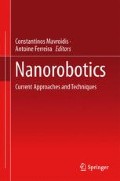Abstract
This chapter begins with a brief assessment of the state of the art in nanorobot hardware. Then, it focuses on programming and coordination issues that arise when large numbers of nanorobots are used for tasks such as building prescribed shapes. The active self-assembly system developed at the University of Southern California is discussed as an example of a proposed system that is capable of constructing arbitrary shapes. The system compiles the desired shape into a set of reactive, stateless rules to drive a large swarm of identical and identically programmed robots. Extensive simulations show that the system self-organizes and is capable of self-repair when numerous faults are present. The chapter concludes with a brief discussion of the current limitations of nanorobotic swarms, and an outlook on future developments.
Access this chapter
Tax calculation will be finalised at checkout
Purchases are for personal use only
References
Currelli M, Zhang R, Ishikawa FN, Chang H-K, Cote RJ, Zhou C, Thompson ME (2008) Real-time, label-free detection of biological entities using nanowire-based FETs. IEEE Trans Nanotechnol 7:651–667
Browne WR, Feringa BL (2006) Making molecular machines work. Nat Nanotechnol 1:25–35
Bath J, Turberfield AJ (2007) DNA nanomachines. Nat Nanotechnol 2:275–284
Wang J, Manesh K (2010) Motion control at the nanoscale. Small 6:338–345
Dong L, Nelson BJ, Fukuda T, Arai F (2006) Towards nanotube linear servomotors. IEEE Trans Autom Sci Eng 3:228–235
Zhang L, Abbott JJ, Dong L, Kratochvil BE, Bell D, Nelson BJ (2009) Artificial bacterial flagella: fabrication and magnetic control. Appl Phys Lett 94:064107
Martel S, Mohammadi M, Felfoul O, Lu Z, Pouponneau P (2009) Flagellated magnetotactic bacteria as controlled MRI-trackable propulsion and steering systems for medical nanorobots operating in the human microvasculature. Int J Robot Res 28:571–582
Braitenberg V (1984) Vehicles: experiments in synthetic psychology. MIT Press, Cambridge, MA
Dhariwal A, Sukhatme GS, Requicha AAG (2004) Bacterium-inspired robots for environmental monitoring. In: Proceedings of the IEEE international conference on robotics & automation (ICRA ‘04), New Orleans, LA, 25–30 April, pp 1436–1443
Akyildiz IF, Brunetti F, Blazquez C (2008) Nanonetworks: a new communication paradigm. Comput Netw 52:2260–2279
Cubukcu E, Cort EA, Crozier KB, Capasso F (2006) Plasmonic laser antenna. Appl Phys Lett 89:093120
Kosako T, Kadoya Y, Hofmann HF (2010) Directional control of light by a nano-optical Yagi-Uda antenna. Nat Photon 4:312–315
Tian B, Zheng X, Kempa TJ, Fang Y, Yu N, Yu G, Huang J, Lieber CM (2007) Coaxial silicon nanowires as solar cells and nanoelectronic power sources. Nature 449:885–889
Pan C, Fang Y, Wu H, Ahmad M, Luo Z, Li Q, Xie J, Yan X, Wu L, Wang ZL, Zhu J (2010) Generating electricity from biofluid with a nanowire-based biofuel cell for self-powered nanodevices. Adv Mater 22:5388–5392
Hogg T (2008) Distributed control of microscopic robots in biomedical applications. In: Prokopenko M (ed) Advances in applied self-organizing systems. Springer, London
Shen W-M, Will P, Galstyan A, Chuong C-M (2004) Hormone-inspired self-organization and distributed control of robotic swarms. Autonom Robot 17:93–105
Werfel J, Ingber D, Nagpal R (2007) Collective construction of environmentally-adaptive structures. In: Proceedings of the IEEE/RSJ international conference on intelligent robots and systems (IROS ‘07), San Diego, CA, 29 October–2 November, pp 2345–2352
Klavins E (2004) Directed self-assembly using graph grammars. Foundations of Nanoscience: Self Assembled Architectures and Devices, Snowbird, UT
Christensen AL, O’Grady R, Dorigo M (2008) SWARMORPH-script: a language for arbitrary morphology generation in self-assembling robots. Swarm Intell 2:143–165
Arbuckle DJ, Requicha AAG (2009) Self-assembly and self-repair of arbitrary shapes by a swarm of reactive robots: algorithms and simulations. Autonom Robot 28:197–211, Published online on 7 November 2009 (Published also as Tech. Rept. AR-07, Laboratory for Molecular Robotics, University of Southern California, 2007)
Arbuckle DJ, Requicha AAG (2004) Active self-assembly. In: Proceedings of the IEEE international conference on robotics & automation (ICRA ‘04), New Orleans, LA, 25–30 April, pp 896–901
Arbuckle DJ, Requicha AAG (2005) Shape restoration by active self-assembly. Appl Bionics Biomech 2:125–130 (An earlier version appeared in Proc Int’l Symp on Robotics & Automation (ISRA ‘04), Querétaro, Mexico, 25–27 Aug 2004, pp 173–177)
Arbuckle DJ, Requicha AAG (2006) Self-repairing self-assembled structures. In: Proceedings of the IEEE international conference on robotics & automation (ICRA ‘06), Orlando, FL, 15–19 May, pp 4288–4290
Arbuckle DJ, Requicha AAG (2007) Global-to-local rule generation for self-assembly and self-repair by robot swarms. In: Proceedings 4th conference on foundations of nanoscience (FNANO ‘07), Snowbird, UT, 18–21 April, pp 251–255
Requicha AAG, Arbuckle DJ (2006) CAD/CAM for nanoscale self-assembly. IEEE Comput Graph Appl 26:88–91
Tangchoopong T, Requicha AAG (2009) An empirical study of the performance of active self-assembly. In: Proceedings of the IEEE/RSJ international conference on intelligent robots and systems (IROS ‘09), St. Louis, MO, 11–15 October, pp 1838–1842
Author information
Authors and Affiliations
Corresponding author
Editor information
Editors and Affiliations
Rights and permissions
Copyright information
© 2013 Springer Science+Business Media, LLC
About this chapter
Cite this chapter
Requicha, A. (2013). Swarms of Self-Organized Nanorobots. In: Mavroidis, C., Ferreira, A. (eds) Nanorobotics. Springer, New York, NY. https://doi.org/10.1007/978-1-4614-2119-1_3
Download citation
DOI: https://doi.org/10.1007/978-1-4614-2119-1_3
Published:
Publisher Name: Springer, New York, NY
Print ISBN: 978-1-4614-2118-4
Online ISBN: 978-1-4614-2119-1
eBook Packages: EngineeringEngineering (R0)

